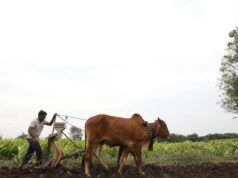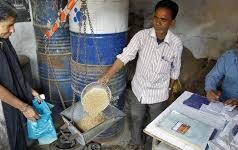India’s stock market is at an all time high level. The Bombay Stock Exchange crossed 23,000 points yesterday gaining 650 points in a single day. In March itself it gained around 1300 points. Finance Minister P. Chidambaram claims the recent surge in market is due to government’s constant efforts to fix the economy by improving the Current Account Deficit. The CAD narrowed sharply to USD 4.2 billion (0.9 per cent of GDP) in Q3 of last financial year from USD 31.9 billion (6.5 per cent of GDP) a year ago. The opposition believes the market is riding on the hope of the change in government which has killed the business environment in the country. Many others too believe that Bharatiya Janta Party (BJP) might come in power and its prime ministerial candidate, Narendra Modi who is seen as business friendly leader, will restore confidence of investors in market. Many also believe that this quarter has a natural upward tendency because of fresh farm product in the market. However, I am afraid that above mentioned factors might not be sufficient reason to give such a boost to market.
India is going through world’s largest electoral exercise, the longest election in the country’s history, from 7 April to 12 May 2014, to constitute the 16th Lok Sabha. There is limit of INR 7 million for urban and INR 5.4 million for rural election expenditure by a candidate but there is no limit on expenditure by political parties. The actual spending is expected to have been approximately 10 times the limit.
Election Commission of India estimates that the election will cost the exchequer INR 35 billion (USD 577 million approx.), excluding the expenses incurred for security and political parties. According to the Centre for Media Studies, parties are expected to spend INR 305 billion (USD 5 billion approx.) in the election. This is the world’s second highest after the USD 7 billion spent on the 2012 US presidential election. According to the CMS study, more than INR 15,000 billion has been spent across various elections held in India over the past five years. Anand Sharma, Union Commerce Minister has accused BJP for spending more than INR 1 trillion in the ongoing election campaign.
India is known for its black economy with largest deposit in Swiss banks. With huge public demand to bring back black money in last few years, there is speculation that the new government might take stringent action. That might be a reason for bringing back the money secretly by those who had it outside the country, and isn’t the election right time to do this? If stock brokers and central agencies tracking the flow of black money are to be believed, INR 150 to 500 billion has returned to India in the last few months via the stock market, gold smuggling and hawala transactions and is being spent on election campaign.
The value of seized gold in 2014 has risen to INR 2.5 billion as against INR 172.2 million in 2011. It is important to note that Participatory Notes investment surged to the highest level of three years at INR 2.07 trillion (over USD 34 billion) in March this year. Participatory Notes commonly known as P-Notes are instruments issued by registered foreign institutional investors (FII) to overseas investors, who wish to invest in the Indian stock markets without registering themselves with the market regulator, Securities and Exchange Board of India. Investing through P-Notes is very simple and hence very popular amongst foreign institutional investors. Government of India has already identified P-Notes as one of the routes through which black money transferred outside India comes back.
It is open to believe or not since the source of information and data regarding black economy has always been a grey area. However, the above indicators do flag a red signal to further probe. So, is the market riding high on black money spent in election? May be, yes.
Post Disclaimer
The opinions expressed in this essay are those of the authors. They do not purport to reflect the opinions or views of CCS.





